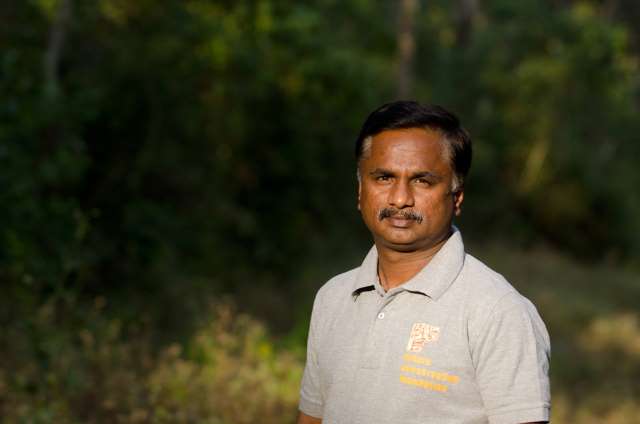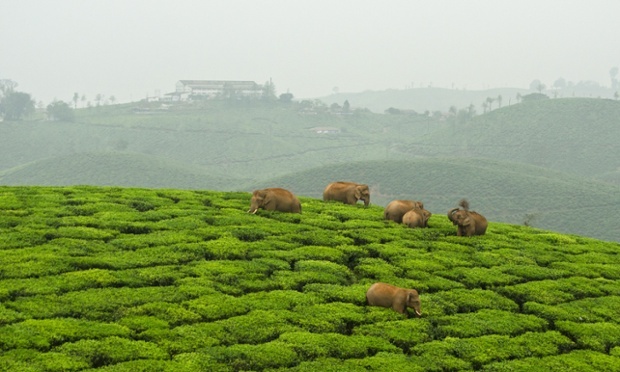‘Green Oscar’ Awarded to the Indian who is solving Human-Elephant Conflict using a Mobile Phone
Ananda Kumar came up with an interesting solution to the human-elephant conflict using a mobile phone. The average number of deaths has drastically after Ananda's intervention. Here's how he did it.

Ananda Kumar came up with an interesting solution to the human-elephant conflict using a mobile phone. The average number of deaths has drastically after Ananda’s intervention. Here’s how he did it.
Life in Valparai plateau in southern India is not an easy one. People are now used to sudden encounters with giant elephants. With such unexpected encounters, both humans and animals fear for their safety leading to larger destruction and loss of life. For centuries, elephants have existed in the thick forests, and with these rainforests getting converted into tea plantations, the animals are left with no choice but to intrude the human space. Though it is not possible to track and control the movement of both humans and animals, it is better to be prepared in advance and avoid mishaps.
A wildlife conservationist Ananda Kumar has come up with an innovative solution to this conflict, where he has managed to save several lives with the help of a simple mobile phone.

Always interested in the field of animal behaviour, Kumar was first introduced to this work by his professor. “I used to watch monkeys and really liked to observe their behaviour, and gradually developed my interest in this field,” Kumar recalls. But it was his stint with a local plantation company that hired him to deal with elephant-human conflict that gave a better shape to his passion.
“I observed elephants. They are very intelligent creatures and love to live in peace. Their encounter with humans is inevitable; it is the negative interaction that causes damage. People have been co-existing with them for centuries and this is what they should do now. It is the helplessness of both animal and human that creates panic. If people are empowered to deal with such situations than such destruction will not happen,” says Kumar.
Ananda then started his work to solve this issue, and along with two more wildlife conservationists, came up with an interesting solution. The crucial part was to track the elephant and let people know its presence to avoid any conflict. With the help of local people and the government, he managed to implement a solution where the location of the elephant was shown on TV as a tick crawl, which helped people to be aware of the elephant presence and plan their outdoor activities in a more informed way.
But what about the people already out in the field? Kumar started a mobile SMS service where the users are notified via text messages about the elephant presence in a particular area. The messages are sent in both English and Tamil language.
“And for those who did not even have a mobile phone or were out of network area, we installed lights. These lights blink whenever there is an elephant in a 2 kms radius,” says Kumar.
These lights are operated through three registered mobile numbers. One of these numbers is of Kumar’s team and the other two numbers are of local citizens selected by the residents. Started in 2002, this service has already reached out to over 3,000 mobile phone users and saved several lives.
Before the implementation of this service, Valparai plateau in Tamil Nadu recorded an average three deaths annually due to elephant-human encounters. After this programme came into the picture, the average number of deaths has gone down to just one per annum.

“Even if a message is delivered to one number, that person can forward it to his family and friends, which will eventually reach out to a larger number of people. People can plan their activities accordingly as they are prepared. There is also less panic among people,” he says.
In his many years of service in this field, Kumar has observed that there is a high level of tolerance among both elephants and humans and they do not attack each other without provocation. “The elephants do not enter the house if there is someone inside. Similarly, humans do not attack the elephants first; they generally try to save their own lives and run away. This shows that both of them can co-exist only if the right intervention is done and people are enabled to deal with the situation in an appropriate manner,” says Kumar.
Though reaching out to the people was initially a difficult task, as any new idea takes time to get acceptance. But the instant impact of the service built trust among the people. Gradually, dangerous encounters and incidents of damage to property and life started falling after introduction of this early warning system.
Kumar has recently received the Whitley Award for his extra ordinary contribution in reducing human-elephant conflict. The award, which is called the “Green Oscar”, is yet another feather in Kumar’s hat.
He plans to further strengthen the warning system of elephant presence, extend it to include other animals, and expand his area of work to different regions of Karnataka and other states.
“Every animal is unique and its behavior is different too. We want to understand that and approach them accordingly. We also want to reduce the crop damage due such conflicts,” he says.
Having effectively solved one of the most crucial issues, Kumar advises people to be more patient and have better understanding of their local region. He is now working in Sathyamangalam Tiger Reserve, a forest-farm landscape that supports subsistence farmers at risk of elephant crop damage. To know more about his work, contact him at – [email protected]
Like this story? Or have something to share? Write to us: [email protected], or connect with us on Facebook and Twitter (@thebetterindia).
This story made me
-
97
-
121
-
89
-
167
Tell Us More
We bring stories straight from the heart of India, to inspire millions and create a wave of impact. Our positive movement is growing bigger everyday, and we would love for you to join it.
Please contribute whatever you can, every little penny helps our team in bringing you more stories that support dreams and spread hope.



















